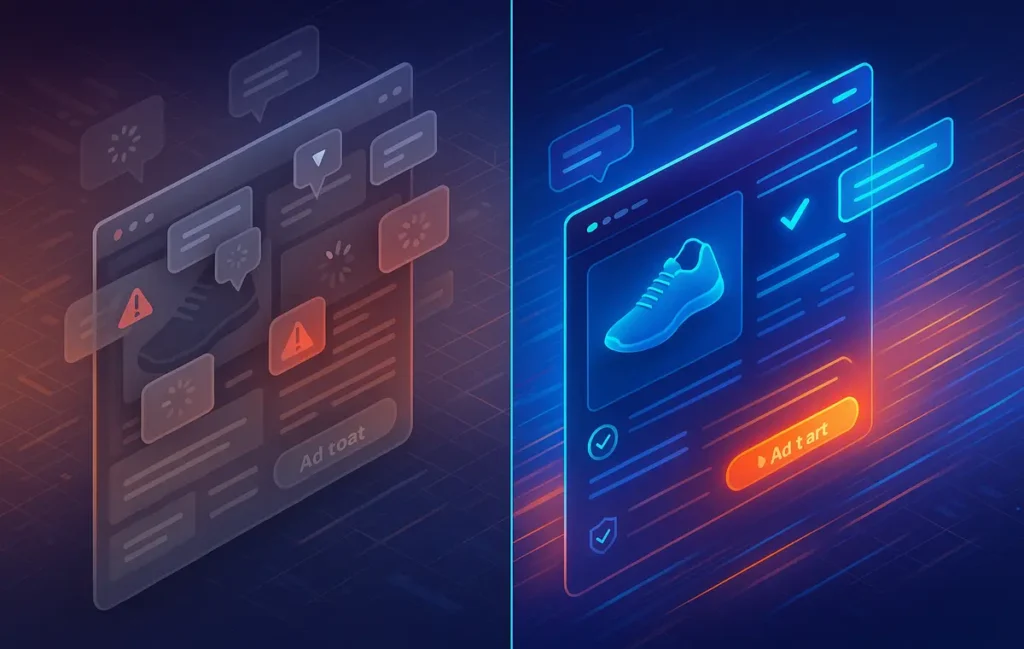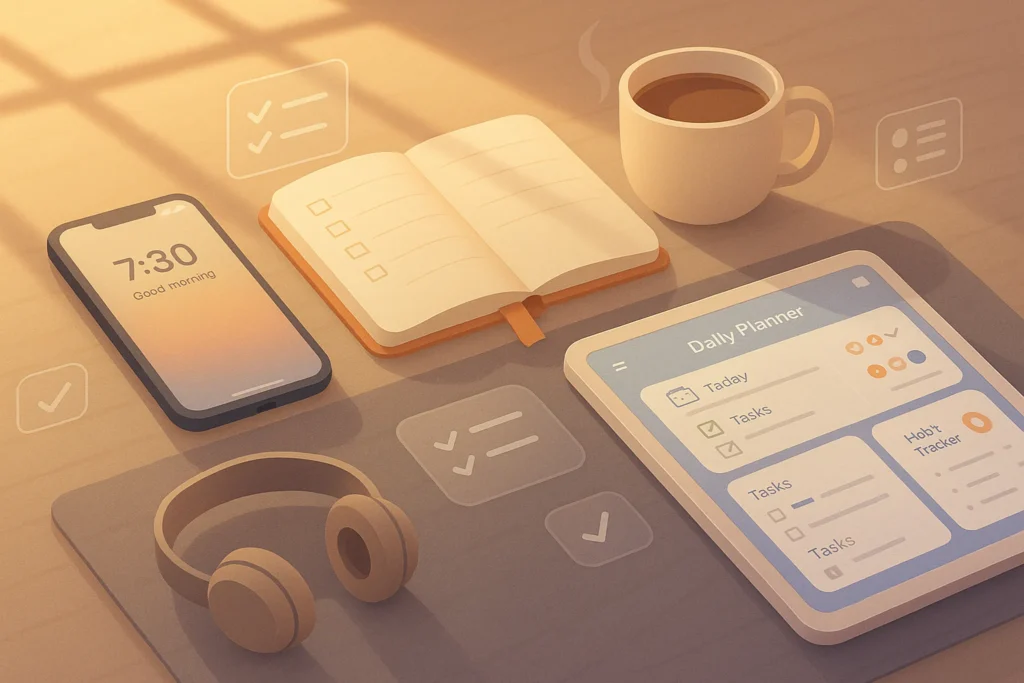🔥 Intro Hook: Why So Much Traffic, Yet So Few Sales?
Every eCommerce entrepreneur eventually hits the same wall: product pages attract steady traffic, yet sales refuse to grow. It’s one of the most frustrating paradoxes in online business. Visitors are arriving, but they aren’t clicking “buy.”
The reason is rarely the product itself. Instead, it’s the page experience. Product pages act as digital storefronts, and if they fail to build trust, remove friction, and load instantly, users leave. Many online retailers spend heavily on ads and SEO (sometimes investing in top PPC management tools or technical SEO) only to funnel visitors into leaky product pages. Without Conversion Rate Optimization (CRO), this traffic is wasted.
💡 Nerd Tip: Treat your product page like a salesperson. If it doesn’t earn trust, guide the visitor, and close smoothly, no traffic source can save it.
✅ The Role of Proof in CRO
Proof is the first building block of a high-converting product page. Customers don’t buy claims; they buy evidence.
Reviews and testimonials remain the gold standard. Studies show that displaying even five authentic reviews can increase conversions by up to 270% compared to pages with none. The quality of reviews matters too—detailed feedback describing specific outcomes carries far more weight than vague praise.
Case studies offer another powerful form of proof. For example, a fitness equipment store that published before-and-after results with real customer photos saw conversion rates jump by 18%. Buyers saw themselves reflected in the success stories.
Social proof elements such as trust badges (PayPal Verified, Norton Secured) reinforce safety, especially for first-time buyers. For mobile shoppers, who often abandon carts due to fear of fraud, these badges reduce hesitation.
User-Generated Content (UGC) has become a CRO game-changer. Shoppers increasingly trust unfiltered content shared by other buyers over polished brand visuals. Incorporating UGC galleries, Instagram photo embeds, or hashtag campaigns allows new visitors to see authentic usage. According to one eCommerce director: “We added a scrolling gallery of real customers using our skincare. Within weeks, conversion rates grew 22%.”
💡 Nerd Tip: Proof isn’t decoration—it’s persuasion. Place reviews and trust signals directly near CTAs, not buried at the bottom of the page.
🎯 UX Principles That Convert
A beautiful product page that confuses users won’t sell. Conversion-focused UX is about clarity, simplicity, and trust.
Clear hierarchy ensures that a visitor instantly grasps the product’s value. The headline should state the benefit, not just the product name. Sub-headlines support the core message, while CTAs remain bold, visible, and consistent throughout the page. A cluttered layout dilutes decision-making.
Mobile-first design is non-negotiable. Over 70% of eCommerce traffic now originates from smartphones. Product pages must adapt to smaller screens without burying CTAs below endless scroll. Thumb-friendly buttons, collapsible menus, and simplified checkout forms directly influence conversions.
Frictionless checkout is often the biggest untapped win. A recent CRO audit revealed that a brand was losing nearly 15% of customers simply because guest checkout wasn’t offered. By adding a one-click checkout option, they recovered lost sales without additional ad spend.
Accessibility is another underrated UX pillar. Alt text for product images, high-contrast buttons, and screen-reader compatibility not only expand audience reach but also reinforce trust. When customers feel included, they are more willing to buy.
💡 Nerd Tip: Map your product page like a funnel: headline → benefit → proof → CTA → checkout. Remove any element that distracts from this journey.
⚡ Speed Optimization for Product Pages
No matter how persuasive your proof or polished your UX, if your page loads slowly, conversions will collapse. Google’s Core Web Vitals have made speed not just a ranking factor but a conversion driver.
Research from Google indicates that even a one-second delay in page load can reduce conversions by 7%. For high-traffic eCommerce stores, that can mean millions lost annually. Speed is not cosmetic—it’s profit.
Image compression remains one of the easiest fixes. High-resolution product images must be optimized without losing clarity. Tools that enable lazy loading prevent offscreen images from slowing initial rendering.
CDNs (Content Delivery Networks) and aggressive caching strategies accelerate delivery across geographies. For brands scaling globally, serving assets from edge servers ensures international buyers don’t suffer slowdowns.
Real-world benchmarks highlight the ROI of speed optimization. One online apparel store improved its Largest Contentful Paint (LCP) score by 1.2 seconds after switching to a modern CDN. Their conversion rate grew by 12% in the following quarter.
💡 Nerd Tip: Run speed tests monthly. Performance degrades over time as you add plugins, scripts, and assets. Continuous optimization is CRO insurance.
📊 Integrating CRO with Analytics
CRO without analytics is guesswork. To improve product pages, brands must measure, test, and adapt.
A/B testing headlines and CTAs is the cornerstone. Tools like A/B Testing Made Easy simplify experiments that reveal what resonates. Subtle shifts in phrasing—such as “Buy Now” versus “Start My Trial”—can lead to measurable uplifts.
Heatmaps and session replays provide visual insights into where users click, hover, or drop off. For example, if heatmaps reveal customers never scroll to reviews, reposition them higher on the page. If session recordings show rage-clicking on unclear buttons, redesign becomes a priority.
Conversion funnels track how many users move from product view to cart to checkout. Identifying drop-off points allows you to diagnose UX or trust gaps. Pairing this with data-driven content ensures that optimization aligns with actual user behavior, not assumptions.
💡 Nerd Tip: Every product page is a hypothesis. Test, measure, and refine until your data shows you’re maximizing every visitor.
📈 Case Study: A Simple CRO Win in Action
Consider an electronics retailer struggling with stagnant sales despite rising ad spend. Their product pages were informative but lacked trust elements.
The CRO audit identified three fixes: adding 10 customer reviews per product, moving the “Add to Cart” button above the fold, and compressing images to improve load speed. Implementation required no major redesign—just tactical improvements.
Within six weeks, their conversion rate rose from 1.9% to 3.4%. That’s nearly an 80% increase in sales without new ad campaigns. The founder remarked: “We didn’t change our marketing. We just fixed the bottlenecks on the page. Suddenly, traffic we already had started buying.”
This case proves the CRO equation: Proof + UX + Speed = Sales.
⚡ Optimize Your Pages Today
Want faster, higher-converting product pages? Use CRO tools and speed testing platforms to find what’s slowing you down—and fix it now.
🧠 Psychology of Persuasion in Product Pages
Conversion is rarely just about layout—it’s about psychology. Visitors arrive at a product page with a mix of hopes, fears, and hesitation. Smart CRO taps into persuasion principles that guide decision-making. Scarcity, for instance, creates urgency. A simple message like “Only 3 left in stock” signals to the buyer that waiting means missing out. Similarly, countdown timers during flash sales leverage the fear of loss, nudging customers toward quicker action.
Social proof works at a psychological level too. When buyers see that others have purchased or endorsed a product, it reduces the perceived risk of making a bad decision. Reciprocity plays its part as well: offering a free bonus, shipping, or small gift creates a sense of obligation to return the favor—often in the form of completing a purchase.
💡 Nerd Tip: CRO isn’t just data and design—it’s also behavioral science. Apply principles of persuasion ethically to guide customers toward the right decision faster.
✍️ Microcopy & Messaging
In CRO, small words often have big impact. Microcopy—the short snippets of text around forms, CTAs, or checkout processes—helps remove friction and reassure buyers. Consider the difference between a button that says “Submit” and one that says “Get My Order Now.” The latter frames the action as a benefit, not a chore.
Error messages and trust reassurances matter too. Instead of “Invalid card info”, a better microcopy would say “We couldn’t process your card—don’t worry, no charges applied.” That small phrase eliminates anxiety and prevents cart abandonment. Similarly, phrases like “No credit card required”, “Free returns in 30 days”, or “Secure checkout powered by SSL” reduce hesitation and push visitors over the finish line.
💡 Nerd Tip: Audit every piece of text on your product page. Microcopy is the voice whispering in the customer’s ear at the moment of decision.
🛒 Cross-Selling & Upselling Integration
CRO doesn’t just mean more conversions—it also means higher-value conversions. Smart product pages integrate upselling and cross-selling elements without disrupting the main purchase path.
Upselling often appears as premium versions of the product: “Upgrade to the Pro bundle for just $20 more.” Cross-selling introduces complementary products that increase basket value: “Pair this laptop with a wireless mouse at 10% off.”
When done well, these additions improve customer experience by anticipating needs. Amazon reports that 35% of its revenue comes from cross-sell recommendations. A simple module under the CTA, showing complementary products, can transform average order values significantly.
💡 Nerd Tip: CRO doesn’t end at the “Buy Now” button. Design your product page to maximize both conversions and cart value with subtle, helpful recommendations.
🤖 Personalization & AI-Driven CRO
The next wave of CRO is personalization powered by AI. Static product pages treat every visitor the same, but AI-driven tools analyze behavior, intent, and history to adapt content in real time.
For instance, if a returning visitor previously abandoned a cart, the page might display a special discount or a reminder of what they left behind. First-time visitors might see educational proof elements like testimonials, while repeat buyers get loyalty offers.
Email integrations powered by AI go further, syncing with ultimate guide to building an email list with AI tools. Imagine an AI tool that learns which CTA phrasing works best for each segment, or which proof element (reviews, UGC, case studies) resonates most with different customer profiles.
💡 Nerd Tip: Personalization isn’t about flashy tech—it’s about relevance. The closer your product page feels to each user’s context, the higher the conversion rate.
🛡️ Trust Beyond Proof: Policies & Guarantees
Proof builds trust, but sometimes it’s not enough. Policies and guarantees create the safety net buyers need to complete a purchase. A bold “30-Day Money-Back Guarantee” can make hesitant customers confident enough to take the leap. Transparent shipping policies—clearly stating delivery times, costs, and return options—remove last-minute friction that often derails conversions.
Guarantees don’t just reduce anxiety; they also increase perceived product quality. When a brand is confident enough to back its products with guarantees, customers assume the risk of dissatisfaction is low. This principle is why many top-performing brands openly highlight refund policies near their CTAs instead of hiding them in fine print.
💡 Nerd Tip: Your policies are part of your CRO strategy. Frame them as benefits, not legal disclaimers, and place them where they matter most—right at the buying decision point.
🌍 Globalization & CRO for Different Markets
As eCommerce goes global, CRO strategies must adapt to regional behaviors and expectations. What works in one market may fail in another.
In mobile-first markets like Southeast Asia, product pages must prioritize speed, simplicity, and one-tap checkout. In Europe, buyers expect strong trust signals such as GDPR compliance notices and detailed privacy policies. In the U.S., scarcity and urgency tactics tend to drive faster conversions, while in Japan, highly detailed product descriptions are more effective.
Brands selling across borders often need localized proof—such as testimonials from customers in the same region—or localized policies like free domestic shipping. Even simple tweaks like displaying prices in local currency dramatically increase trust.
💡 Nerd Tip: CRO isn’t universal. Test strategies market by market, adapting proof, UX, and speed to cultural expectations and buying behaviors.
📬 Want More Smart CRO Tips Like This?
Join our free newsletter and get weekly insights on CRO, analytics, and growth tactics—delivered straight to your inbox. No fluff, just strategies you can use.
🔐 100% privacy. No noise. Just value-packed content tips from NerdChips.
🧠 Nerd Verdict
Conversion Rate Optimization isn’t a mystery—it’s a formula. Proof establishes credibility, UX guides the journey, and speed ensures no one abandons mid-process. Together, these pillars transform passive visitors into paying customers.
NerdChips’ take is simple: treat CRO as a discipline, not a project. Continuous optimization compounds over time, turning every product page into a reliable sales engine.
❓ Nerds Ask, We Answer
💬 Would You Bite?
If one CRO tweak could boost your sales by 20%, which would you test first: proof, UX, or speed?
Crafted by NerdChips for creators and teams who turn every click into a customer journey.



